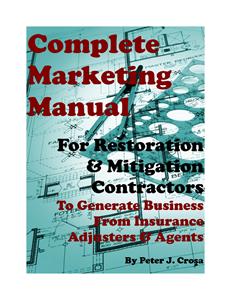Web Exclusive
Hiring Asbestos Contractors and Liability

Asbestos is supposed to be a thing of the past yet contractors and consumers must protect themselves by being aware of its presence.
There is a lot of misunderstanding around asbestos abatement. The most prevalent use of asbestos has been in commercials promoting lawyers who represent those who have are suffering with terrible illnesses such as mesothelioma or asbestosis. For the majority of our populace, we believe it was in those odd 9 inch by 9 inch tiles in the schools of our youth and suspect it’s in the ugly popcorn ceilings that we see in older homes, but we don’t always view it as a current issue. Unfortunately, there is still plenty of asbestos in existing structures as well as instances of it potentially being used in on-going production such as recent cases with Claire’s makeup as well as Johnson & Johnson’s talcum powder. While our individual exposure is not always at and increased level, asbestos is still being imported into the United States and there are several materials which contain varying amounts of asbestos in them.
Asbestos in homes and buildings
We all typically fall into one of two categories when it comes to our living arrangements, we either rent or we are in the process of buying our home from a bank (ownership). Asbestos was initially utilized in structures because it had some superior qualities for key elements such as heat resistance and bonding. “Because of its strength, asbestos was added to concrete, asphalt, vinyl materials in roof shingles, pipes, siding, wall board, floor tiles, joint compounds and adhesives.” Whether you live in an apartment or a home, there is the potential for asbestos materials to have been used in some aspect of your structure. This is not intended to raise panic level but rather to elevate awareness so that you are not unwittingly exposed.
Current issues with abatement contractors
For instance, in July of 2018, an asbestos abatement contractor in Washington State was cited for multiple violations for improper handling of asbestos resulting in citations and up to $229,700 in fines. The contractor in this story had a history of being a severe violator and was still getting work which means contractors, property managers, business owners and homeowners were either not doing their homework or unaware that this information was available to assist them in making better informed decisions. The Edmonds, Washington based contractor is not alone in their negligence as a quick search on Google can pull up several current asbestos abatement contractors with violations in the Pacific Northwest and beyond. When faced with asbestos and needing to hire an abatement contractor, it is important to ensure you are hiring the right professionals to assist you or what should be a routine problem with an orderly response can become a much bigger issue.
Building owners and property managers responsibility with asbestos
Commercial projects often bring a bit more scrutiny as they can be higher profile with multiple stake holders involved. The structure owner, property manager, general contractor and abatement contractor’s all have exposure when working to remove hazards such as asbestos. Each of the parties involved have both exposure to the hazard as well as culpability in a negligent response to addressing asbestos. Abatement activities in Washington State require notification to Labor and Industries (L&I) as well as a permit from the presiding local environmental agency, failure to do can result in daily fines for each party involved. There is the potential in any asbestos removal for either agency to make a visit to confirm that abatement work is being completed in a manner that protects workers (OSHA), occupants and the environment.
In Washington State, failure to file a report of an asbestos abatement could result in severe fines. “State law specifies a minimum $250 per day fine for failure to obtain an asbestos report. This fine can be applied to both the contractor and building owner. Additional fines may be applied if workers are exposed to airborne asbestos.”
What is an asbestos violation?
One of the violations for the contractor cited was related to, “The emergency removal of boiler insulation in a Seattle apartment complex.” L&I cited the asbestos abatement contractor for “multiple willful and serious violations”. Asbestos is a known hazard but does not become probable for risk of exposure until it is damaged or being removed. The terminology used for asbestos is friability. When an asbestos containing material (ACM) can be crumbled or pulverized then it becomes friable which leads to a higher likelihood that the fibers can become airborne. In a commercial setting such as an apartment complex this exposure can affect building occupants, tenants, site staff and workers. Educating yourself on the process of asbestos abatement can help you to make a more informed decision on the contractor you hire to assist you with your issue. We will outline this process further in the closing of this article.
According to the article we referenced from Edmonds News, “In both cases, the workers did not use proper safety equipment, required air sampling was not performed, and asbestos-containing material was left exposed to the public and was improperly taken through public areas.” Whether a contractor is handling hazardous materials or general debris, organizations with high standards want to create and maintain a clean working environment. Dust free is required with asbestos abatement as well as many other remediation activities including microbial growth (mold), but it should be standard practice for construction in general. When a consumer selects a vendor based upon price alone, you have to question what is being sacrificed in order to reach that figure? As noted above, improperly taking materials through public areas is the definition of cross contamination.
Who is affected by an asbestos violation?
Distinctions are made between types of violations including willful, serious and negligence. Contractors who are cited are able to appeal the citation and go through a process of defending their actions. Consideration is also given for the abatement contractors track record. In the case we have been discussing, when asbestos workers are not following protocol they are potentially impacting themselves, fellow workers, building occupants, the public as well as their own families if they bring those contaminants home on their clothing. Some of the questions that would be asked would include whether the company has properly trained their employees, did they provide the necessary tools and protective equipment as well as a review of the companies citation history.
Unfortunately, the company in this story was also recently cited for violations related to removal of asbestos containing popcorn ceiling material in a single-family residence. Home ownership is on the rise, which is a great thing for families and our economy. Because the market is so competitive, many eager homeowners are looking at value buys which often includes purchasing older homes to either remodel into dream spaces or flip for a profit. All parties should educate themselves on the basics of where asbestos is likely to be used in a structure and ask that this be disclosed when considering the purchase of a home. Asbestos can be abated and there is an orderly process for this when you team up with the right professionals to assist you with your needs. Knowing what the hazards are and what your estimated costs would be are invaluable to making a good decision.
General contractor’s responsibility for asbestos abatement
If you are a general contractor, property manager or building owner hiring an abatement company as a who specializes in asbestos, you need to know their work history and adherence to the regulations as improper removal could affect your company. If you are a homeowner who is in need of asbestos abatement, the least expensive option may not be the best option and the selection of the wrong contractor could be very costly. As with all industries, the majority of asbestos abatement contractors are hard working people who pride themselves in doing things the right way. Choosing the right asbestos abatement contractor can make the process of removing hazards safe and smooth.
General contractors understand that they have a responsibility to create a culture of safety within their own organization. Most companies that we have worked with in the property restoration field are actively working to achieve these goals. It is more important than even to understand that this culture must extend to your partners and vendors as so much is at stake with the work that our organizations do. Recent cases like the Keodalah ruling out of Washington State remind us that liability can be extended to multiple parties when there is a concern over damages. Whether you are a general contractor, business owner, property manager or a homeowner, educate yourself so that you can make informed decisions.
How can you find the right asbestos abatement contractor?
- Confirm the contractor is licensed to complete asbestos abatement in your state and/or county. In Washington State this is overseen by Labor and Industries which has a list on their website of state certified asbestos abatement contractors.
- Check their license history to determine if they have any violations and/or citations. Most states have a contractor’s board that oversees contractors and their listing on that directory will include their workplace health and safety history, citations and/or violations. Often you can see whether they have current items being reviewed or if prior cases were brought to resolution.
- According to the article cited above on the abatement contractor in Washington State, they were reported to have been on the L&I “severe violator” list and were at risk for being de-certified as they had a history of similar issues.
- As with all contracting opportunities, it is recommended to get a minimum of 3 estimates. The theory here is that you can compare whether all contractors are in the same ballpark with their cost estimates as well as their explanation of the scope of work to be completed. If there is a high, middle and low bidder, what are the reasons for the variances in their estimates? Low bid isn’t always the best bid but that doesn’t mean the most expensive one is either. Having three contractors allows you to get a sense for who you would like to work with, who is the most responsive to your questions and who can explain their process in a manner that makes sense to you.
- With free tools such as Yelp and Google reviews, you can view the feedback of other consumers with the vendors you are interviewing. There are resources that you can pay for but as these free databases grow in popularity they can be helpful in your research.
- Know the process. Removal of asbestos should be detailed and orderly. The hazard must be removed without making the problem worse. In general (brief overview) an asbestos abatement requires a few key elements:
- Identification of the hazards, this is usually accomplished with an asbestos survey completed by a certified AHERA building inspector.
- The samples taken in the asbestos survey will be sent to a NVLAP certified lab where they will determine whether the samples contain asbestos or not.
- Once the samples are identified as containing asbestos (typically over 1% is considered positive) they are classified as friable or non-friable.
- With the asbestos survey, sample results and classifications of materials then an asbestos abatement plan for those asbestos containing materials can be put together for your specific project.
- An asbestos abatement scope and estimate should address how the contractor is going to reduce cross contamination – how are they going to remove the hazards without making the problem worse or spread to other areas while they conduct their work. Typically this includes containment of the affected area(s) with thick plastic sheeting, negative air pressure with HEPA filtered air scrubbers, personal protective equipment for workers including respirators and coveralls, double bagging debris and lots of cleaning of everything.
- Proper disposal of asbestos containing materials in a landfill designated for this regulated waste. Improper transportation and disposal of asbestos containing materials can be very harmful and costly.
Looking for a reprint of this article?
From high-res PDFs to custom plaques, order your copy today!








